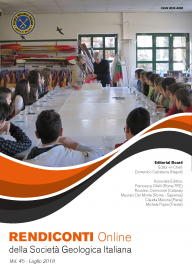
Urban geoheritage as a resource for Earth Sciences education: examples from Milan metropolitan area
Manuela Pelfini (a), Irene Bollati (a), Mauro Giudici (a), Teresa Pedrazzini (a), Matteo Sturani (a) & Michele Zucali (a)
(a) Università degli Studi di Milano, Dipartimento di Scienze della Terra "A. Desio".
Corresponding author e-mail: mauro.giudici@unimi.it
Volume: 45/2018
Pages: 83-88
Abstract
Fieldwork has a great importance in fixing knowledge and acquiring skills and competences in Earth Sciences education; it also represents a starting point for the discovery of geodiversity and geoheritage. Educational activities in urban and suburban areas offer great opportunities and an unique training ground to recognize the role of different processes and landforms after the human reworking.
Moreover, they favour interdisciplinary approaches, which evidence the relationship among geological and geomorphological processes, human activities and culture. Here two different experiences in the Milan (Italy) urban and suburban areas are proposed, to highlight the importance of open-air laboratory for students and future teachers: i) an itinerary in the inner city to classify lithologies used for buildings and street floors in order to recognize not only geological elements but
also the role of geology within human history and life, the materials provenance areas in the framework of Alps geology and water ways used to move them, and ii) a "hydrological" itinerary, from Milan city to the Chiaravalle Abbey and the nearby village, to approach present and past characteristics of fluvial geomorphology and its link with surface- and ground-waters.
Keywords
Field activities, Earth Sciences education, urban geomorphology, hydrology, geodiversity, geoheritage.
Get Full Text